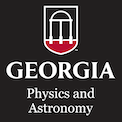Events Calendar View
-
Mathematical Physics Seminar
Oct 30, 2013
The Adomian decomposition
-
CSP Lunch Seminar
Nov 5, 2013
Interactions of atoms, molecules, and surfaces - pushing the limits of accuracy
-
Mathematical Physics Seminar
Nov 6, 2013
- no meeting this week
-
Departmental Colloquium
Nov 7, 2013
Non-thermal Processes on Lunar Surfaces and at Buried Ice: Graphite Grain Interfaces
Photodesorption and photodissociation of H2O following 157-nm irradiation of amorphous solid water deposited on an impact melt breccia from the Apollo 16 mission has been studied. The desorbing H2O and O(3PJ=2,1,0) products were detected with resonance-enhanced multiphoton ionization (REMPI). Vibrationally excited water was also detected with non-resonant ionization. Direct desorption involves exciton decay which is in competition with molecular dissociation events on the surface. Cross sections for H2O (v = 0) removal were found to increase with decreasing coverage and are considerably higher than photodesorption from common metal oxides. This work represents the first measurement of an absolute photodesorption cross section from an actual lunar sample. The vacuum ultraviolet (121.6 nm) synthesis of carbon dioxide on ice-coated graphite and isotopic labeled 13C graphite has also been examined. The results show that CO2 can be formed at the buried ice:graphite interface with Lyman-α photon irradiation via reaction of radicals (O and OH) produced by direct photodissociation and dissociative electron attachment (DEA) of the interfacial water molecules. The synthesized CO2 molecules can desorb in hot photon dominated regions (PDRs) and lost to space when ice coated carbonaceous dust grains cycle within the protoplanetary disks. Thus, non-thermal formation of CO2 at the buried ice:grain interface by VUV photons may regulate the carbon inventory during the early stage of planet formation. This may help explain the carbon deficits in our solar system, and suggests that a universal carbon deficit gradient may be expected within astrophysical bodies surrounding center stars.
-
Mathematical Physics Seminar
Nov 13, 2013
Introductory discussion of the Einstein equation
-
Departmental Colloquium
Nov 14, 2013
Chemical Evolution and Gamma-Ray Astronomy
One of the grand themes of modern astrophysics is the progressive chemical enrichment of the Universe. Since the hot beginnings with little more than hydrogen and helium, the 4% mass fraction of the mostly metal free baryon component has been enriched to about 2%, by mass, in elements beyond H and He. The underlying cycle of star formation, stellar evolution, static/dynamic (explosive) nucleosynthesis and feedback of freshly processed material to the interstellar medium is also critical for our understanding of galactic evolution, and thus our general understanding of the building blocks of the Universe. This colloquium will discuss how gamma-ray astronomy is used to trace some of the relevant quantities involved in local chemical evolution, through "Astronomy with Radioactivities", and how observations in the gamma-ray regime shed light on chemical evolution on cosmic scales.
Page 49 of 121, showing 6 records out of 723 total, starting on record 289, ending on 294


